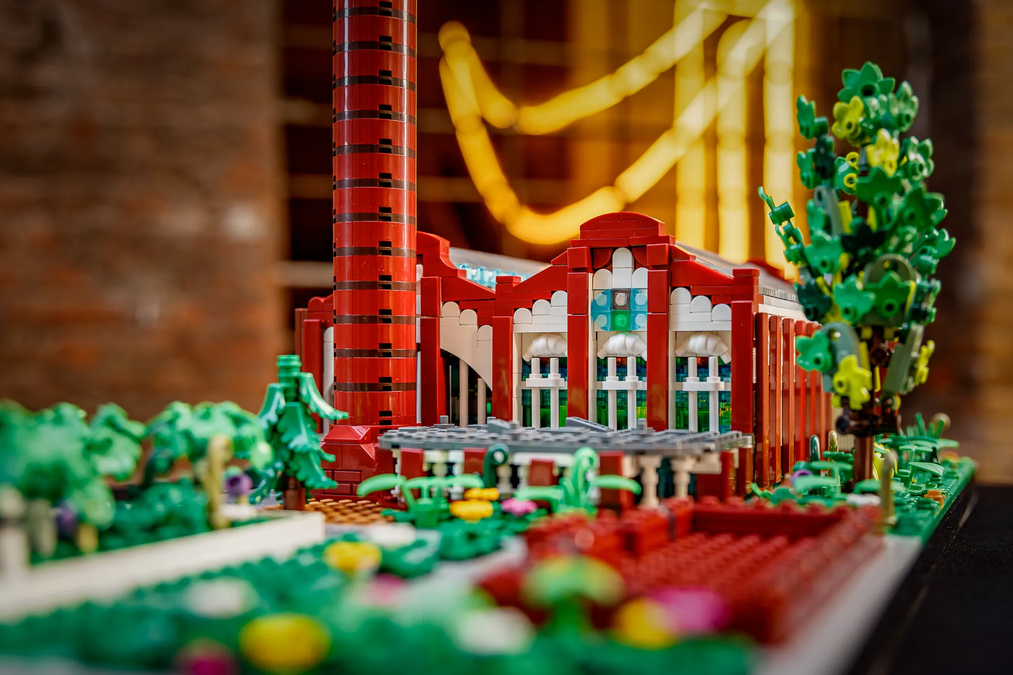Discover one of the most beautiful structures and a European true gem of the industrial Art Nouveau, constructed with great ambition in 1910 by the most powerful manufacturing family of that time, the Scheiblers.
Power Plant Model:
This exceptional building model consists of 2,992 bricks, and its dimensions are 52 cm x 27 cm. The chimney stack, which stands 44 cm tall, is made of 112 curved bricks. The Power Plant features a removable roof, so that you can comfortably look inside... The interior lighting brings out the beauty of the colorful Art Nouveau stained-glass windows, created using 272 translucent bricks. The decorative arches above the windows are created by cleverly attaching white croissant bricks. A significant challenge was capturing the detailing of this lavish building at such a small scale – thus, many innovative building techniques were used to faithfully reproduce its uniqueness, including dividing the windows with delicate white columns and brick columns protruding between them. Pay attention to the tower roof (where the staircase is located) – it is finished with horn bricks and a ski pole. One of the walls of the Power Plant building is covered with a revolutionary material – Corten steel, which is eternally 'rusted', emphasizing the industrial history of the building. The model also reflects the beautiful "Anna's Gardens." The historic brick building is surrounded by lush greenery – gardens full of birches, flowers, hedges, and an old poplar tree that dates back to the founding of the original factory.
Story:
Let me introduce you to the Power Plant, located in Łódź, a city in Poland, famous all over the world for its unique post-industrial infrastructure and scenic red brick buildings (the legacy of this place is written on its red bricks, hence the Lego bricks and the brick are symbols of the historic Power Plant!). It is a revitalised, protected heritige building, featuring two breathtakingly vast spaces – the boiler room with its massive boiler and the engine room with former machinery and captivating large stained-glass windows. The 80-metre chimney stack, adorned with ornaments, completes the city skyline. The Power Plant tells its extraordinary history spanning over a century, and now you too can become a part of it.

By building this model, my goal was to pay tribute to the beautiful concept behind the urban development trend of revitalisation – the restoration of old, forgotten, and closed post-industrial spaces to the city's residents. The Power Plant is a perfect symbol of this process – a one-of-a-kind example on a European scale (an industrial power plant built in the decorative Art Nouveau style) that has been brought back to life. With a contemporary spirit, it now represents a green-filled space (including flowers coming from the chimney stack instead of smoke!) open to cultural, entertainment, sports events, and leisure activities.

Part of the historic Power Plant is its adjoining green area, full of trees, lawns, plants, and relaxation spots. This area, named 'Anna's Gardens', is dedicated to Anna, the doyenne of the Scheibler family, who were builders of the original Power Plant. Anna was a factory owner and a pioneering businesswoman who actively participated in managing the factory for over 40 years and was deeply involved in social matters. It was at her instigation that a hospital was established, along with daycare facilities for workers' children. She also set up a special fund for long-serving workers who were no longer able to work and thanks to a shelter they were guaranteed care. Anna was concerned for the health of the factory workers, their children, and the elderly, while also promoting culture. Thanks to her, the first folk theater in Polish lands was established, where professional actors performed for the workers. She was passionate about gardening, particularly exotic plants. Inspired by Anna, the first horticultural exhibition in Łódź was organized in 1892.





